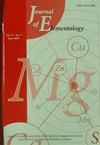Fish as bioindicators of mercury contamination in aquatic environments - an underestimated threat to consumer health
IF 0.7
4区 环境科学与生态学
Q4 ENVIRONMENTAL SCIENCES
引用次数: 0
Abstract
Fish are a recommended component of the diet, supplying complete proteins, vitamins, mineral salts, and omega-3 fatty acids. The presence of mercury in fish tissue, both freshwater and marine, is the effect of its accumulation in the aquatic environment and depends largely on the concentration of mercury in water as well as food. Most of mercury in fish tissues is present in the form of organic complexes, mainly methylmer - cury, which is much more toxic than metallic mercury. In organisms of predatory fish, such as shark, tuna, swordfish, or eel, mercury will be present in concentrations higher than in other species of fish. It is not just the result of their nutrition, but is also related to their age, mobility and habitat. In fish living near the bot - tom of a water body, the concentration of mercury will be much higher. It has to be noted that the ongoing climate change and increase in environmental contamination may significantly raise the bioavailability of mercury and its organic complexes in鱼类作为水生环境中汞污染的生物指标——对消费者健康的一个被低估的威胁
本文章由计算机程序翻译,如有差异,请以英文原文为准。
求助全文
约1分钟内获得全文
求助全文
来源期刊

Journal of Elementology
ENVIRONMENTAL SCIENCES-
CiteScore
1.80
自引率
12.50%
发文量
15
审稿时长
6-12 weeks
期刊介绍:
The Jorunal of Elementology contains original, experimental and review papers pertaining to the transformations of organic and mineral compounds. The research problems encompass organic and mineral compounds discussed from the angle of physiology, biochemistry and genetics; complex analyses and assessment of the conditions underlying biogeochemical cycles, symptoms of deficiencies and excess of chemical elements as well as their antagonistic and synergistic interactions. The papers published in the journal discusses problems from the fields of medical and health sciences, forestry, veterinary medicine, natural sciences and chemical sciences.
 求助内容:
求助内容: 应助结果提醒方式:
应助结果提醒方式:


